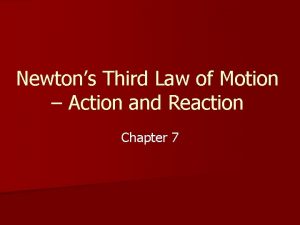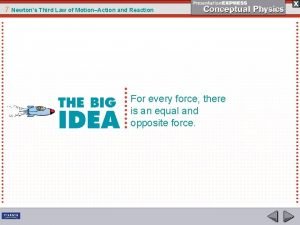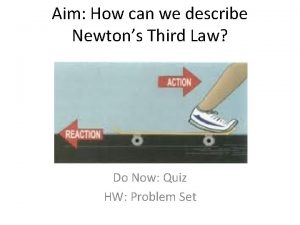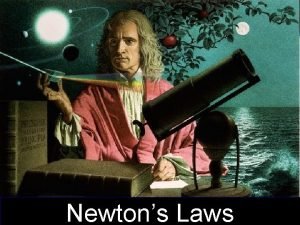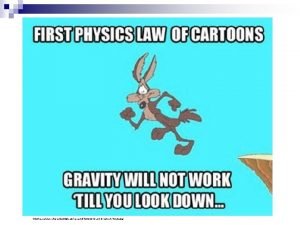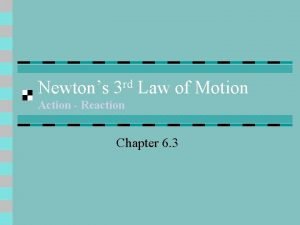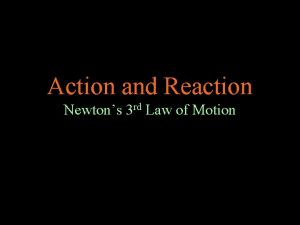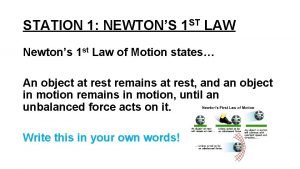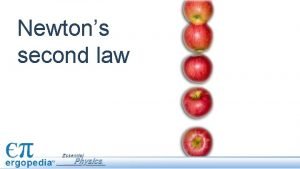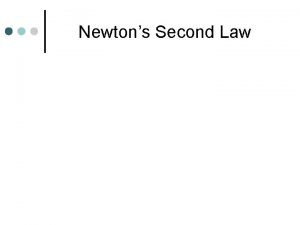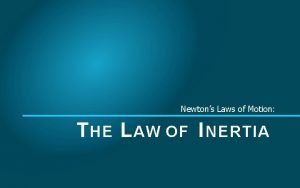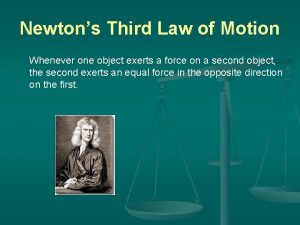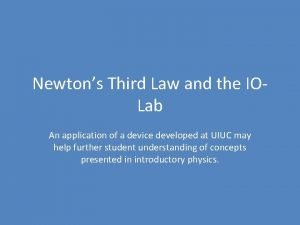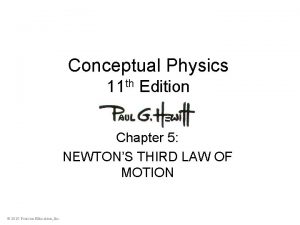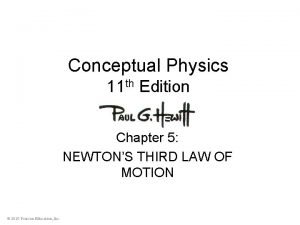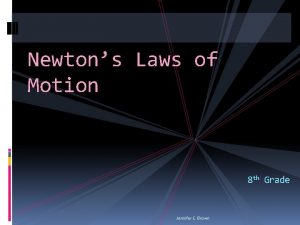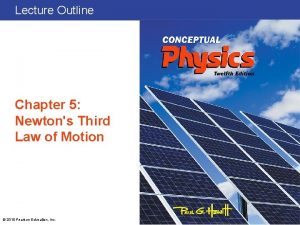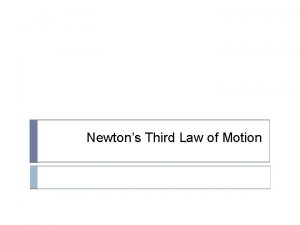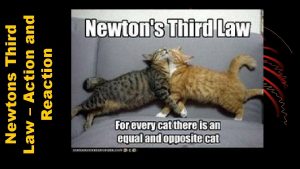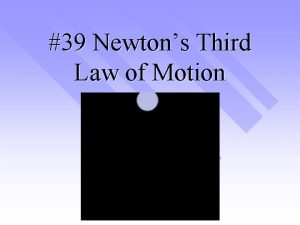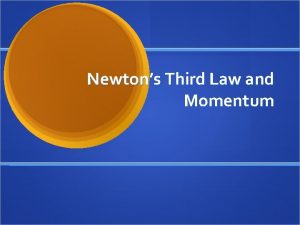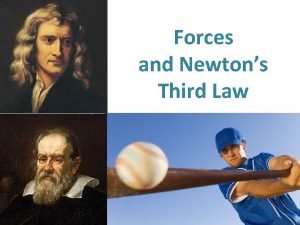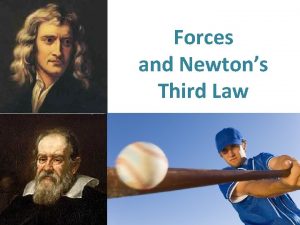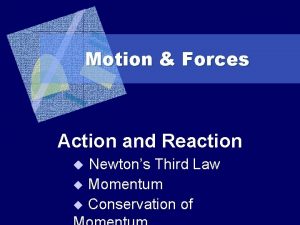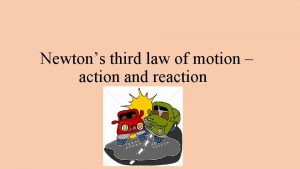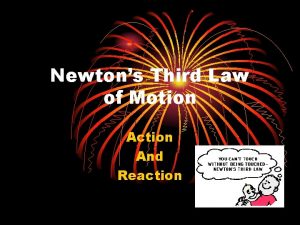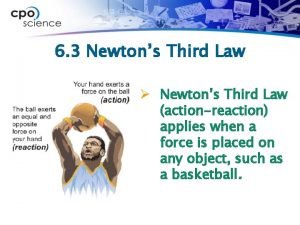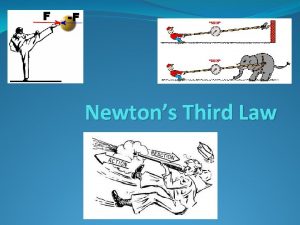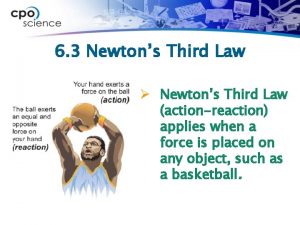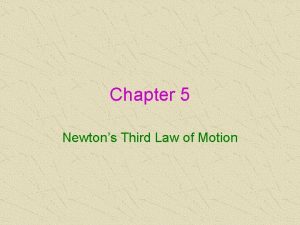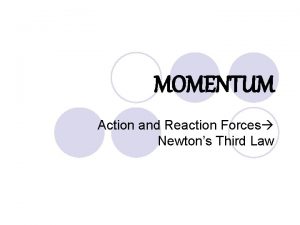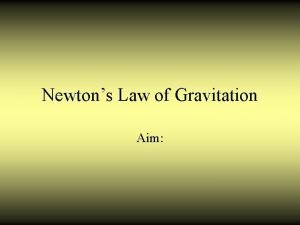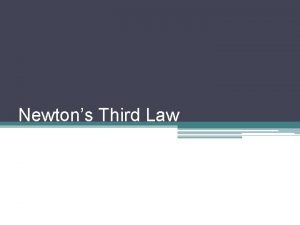Newtons Third Law of Motion Action and Reaction






























- Slides: 30

Newton’s Third Law of Motion – Action and Reaction Chapter 7

Objectives n n n n Define force as part of an interaction. State Newton’s third law of motion. Describe how to identify a pair of action-reaction forces. Explain why the accelerations caused by an action force and a reaction force do not have to be equal. Explain why an action force is not cancelled by a reaction force. Explain how a horse-cart system accelerates. Explain what must occur in every interaction between things.

7. 1 Forces and Interactions n n n Recall (Ch. 2) that a force is a push or pull. According to Newton, a force is always part of a mutual action that involves another force. This mutual action is called an interaction. For example, a bat exerts a force on a ball but the ball also exerts a force on the bat. So for every interaction, there a pair of forces involved.

7. 2 Newton’s Third Law n According to Newton, whenever one object exerts a force on a second object, the second object exerts an equal and opposite force on the first object. • One force is called the action force. • The other force is called the reaction force. n In other words, for every action, there is an equal and opposite reaction.

7. 2 Newton’s Third Law Important points to remember: n In every interaction, the forces always occur in pairs. n The action/reaction forces are always equal in magnitude. n The action/reaction forces are always opposite in direction.

Examples The girl pushes on the wall and the wall pushes on her. The athlete pushes the bar upwards. The bar pushes the athlete downwards. The swimmer pushes backward on the water and the water pushes forward on her

7. 2 Newton’s Third Law Notice that interactions generally depend on friction. n That is, if an action force cannot be exerted (because the surface is ice, for example), there cannot be a reaction force. n There is no resulting forward motion. n

7. 3 Identifying Action and Reaction In the examples given previously, a pattern for identifying the action/reaction pair is apparent. n First, identify the objects “A” and “B”, then follow this simple “recipe”: ACTION: A exerts a force on B REACTION: B exerts on force on A n Example: ACTION: foot pushes against sand REACTION: sand pushes against foot n

Practice A car is cruising down the street. A rocket is lifting off toward space. Bowling ball pushes pin leftwards . A ball is dropped off a very tall building. Baseball is caught in glove. . A sledgehammer drives a stake. n Determine the action-reaction forces of the above interactions.

Check Your Understanding While driving, Anna observed a bug striking the windshield of her car. The bug hit the windshield and the windshield hit the bug. Which of the two forces is greater: the force on the bug or the force on the windshield? n We know that the Earth pulls on the moon. Does the moon also pull on the Earth? If so, which pull is stronger? n In tug-of-war, if you pulling on the rope is the action force, is the reaction force the ground pushing back on you or your opponent pulling back on the rope? n

7. 4 Action and Reaction on Different Masses In the interaction between the boulder and Earth, the boulder will push on the Earth with as much force as the Earth will push on the boulder. The FORCES will be the same. n The masses of the 2 are quite unequal, however. n Since a = F/m, the boulder (low m) will experience a much greater acceleration than the Earth (high m). n The Earth DOES accelerate also but we cannot “sense” it because the acceleration is infinitesimally small. n

Force and Mass Think about the firing of a cannon. n The force the cannon exerts on the cannonball is exactly equal and opposite to the force exerted by the cannonball on the cannon. n The cannonball moves forward and the cannon “kicks” or recoils. They both accelerate but not by the same amount due to their differing masses. n

Force and Mass n Let F represent both the action & reaction forces. n M represents the mass of the cannon and m represents the mass of the ball. n For the cannonball: F = a (large acceleration) For the cannon: F m =a M (small acceleration) The acceleration of the cannonball is great compared to the acceleration of the cannon. n A force exerted on a small mass produces a greater acceleration than the same force exerted on a large mass. n

Force and Mass n Extend this idea to a rocket launch. n Combustion of rocket fuel produces “expanding gases”. Each molecule of exhaust gas acts like a tiny molecular cannonball shot downward. n In reaction. the rocket recoils from the molecular cannonballs shot downward and climbs upward. n No atmosphere is necessary for this action & reaction.

Understanding Lift n n Using Newton’s 3 rd law, we can explain how a helicopter, bird, or plane gets its lifting force. The whirling blades of the copter (or the wings of a bird or the wings of an airplane) force air downward; the air forces the blades (or wings) upward. The upward reaction force is called lift. When lift equals the weight of an object, the object can hover; when lift is greater, it can climb upward.

Understanding Lift n. A plane, though, must continuously push air downward to remain in the air. n A continuous supply of air is produced by the forward motion of the plane. n The forward motion is supplied by jets or propellers. They push air backwards and, in turn, the air pushes the plane forward.

Check your Understanding n Explain why the acceleration of a recoiling gun is much less than the acceleration of the bullet. n Are rockets able to accelerate in space? Why or why not? n A tug-of-war takes place between Ms. P’s physics class and Mrs. D’s. If the floors are polished and slippery and if Mrs. D’s entire class is wearing socks only, who will win and why?

7. 5 Defining Systems • Since action-reaction forces are equal and opposite, why don’t they cancel to zero? • Simply put, the forces do not cancel because they are forces on different systems (different objects).

7. 5 Defining Systems 1 2 • To explain this answer, we must consider the systems involved. • There are 2 systems in the diagram above.

7. 5 Defining Systems In system 1, we see a vector (arrow) extending outside the system. This is a force on the system, so the system accelerates (Newton’s 2 nd Law). n The force was provided by the apple, which is outside the system. Any reaction force (orange on the apple) is outside the system, so it does not affect the orange. n Action and reaction forces do NOT cancel when either force is outside the system being considered. n What if we put a dotted line around the apple instead of the orange? Our system will be the apple so. . . n

7. 5 Defining Systems n In system 2, since the action/reaction forces are within the system, they DO cancel each other. They do not cause the system to accelerate. n A force outside the system – FRICTION – is needed. n The apple pushes on the floor; the floor pushes on the apple. The system accelerates.

7. 5 Defining Systems Another example: a baseball has an immeasurable number of forces between the atoms WITHIN the ball. n These forces hold the ball together; they DO NOT cause the ball to accelerate. n An external force, like a bat, is needed to accelerate the ball. n

7. 6 The Horse-Cart Problem Take a look at the cartoon on pg. 115 in your test. n This “problem” can be thought of as containing 3 different systems. n – – – The cart The horse and cart

7. 6 The Horse-Cart Problem The cart system: the cart will accelerate because there is an external force being place on it by the horse. There is also an external force of friction but this can be discounted because the wheels are smooth and shiny. n The horse system: there is a reaction force from the cart that is external to this system. It will therefore act to restrain the horse. However, the horse also interacts with the ground – the horse pushes backward and the ground pushes forward. n

7. 6 The Horse-Cart Problem If the horse in the horse-cart system pushes the ground with a greater force than it pulls on the cart, there is a net force on the horse and the horse-cart system will accelerate. n The horse-cart system: the pull of the horse on the cart and the cart on the horse are internal forces and do not accelerate the system. The interaction between the horse-cart system and the ground is responsible for motion. n Acceleration = force of the push on the ground mass of the horse and cart n


7. 7 Action Equals Reaction For every interaction between things, there is always a pair of oppositely directed forces that are equal in strength.

Practice n List the forces acting on the – – – Tractor system Elephant system Man system

Practice Consider the interaction depicted above between foot A, ball B, and foot C. The three objects interact simultaneously (at the same time). Identify the two pairs of action-reaction forces. Use the notation "foot A", "foot C", and "ball B" in your statements. n Under what conditions would the ball accelerate? n

Practice If A and B have equal mass, what will happen when they push off from each other? n Suppose A has a greater mass than B. n A B
 According to the third law of motion action and reaction
According to the third law of motion action and reaction Law of motion 3rd
Law of motion 3rd Third
Third Newtons third law
Newtons third law Newtons third law of motion
Newtons third law of motion Newton's first law and second law and third law
Newton's first law and second law and third law Newton's first law of motion
Newton's first law of motion Describe newtons third law
Describe newtons third law Law of thermodynamics in chemistry
Law of thermodynamics in chemistry What is newtons law
What is newtons law Newton's law of motion
Newton's law of motion Newtons 3 rd law of motion
Newtons 3 rd law of motion Newtons 3 rd law of motion
Newtons 3 rd law of motion Rd law
Rd law Newtons first law of motion meme
Newtons first law of motion meme Newtons 3 rd law of motion
Newtons 3 rd law of motion What are newtons 3 laws
What are newtons 3 laws Newtons 3 rd law of motion
Newtons 3 rd law of motion The newton's first law of motion
The newton's first law of motion Newton's 2nd law
Newton's 2nd law Newton's 2nd law example
Newton's 2nd law example Newtons law of motion
Newtons law of motion Newtons first lw
Newtons first lw Newtons first aw
Newtons first aw Newton's third law of motion examples
Newton's third law of motion examples Iolab application
Iolab application First law of motion facts
First law of motion facts Slightly tilted wings of airplanes deflect
Slightly tilted wings of airplanes deflect Slightly tilted wings of airplanes deflect
Slightly tilted wings of airplanes deflect Newton's third law of motion
Newton's third law of motion Slightly tilted wings of airplanes deflect
Slightly tilted wings of airplanes deflect
